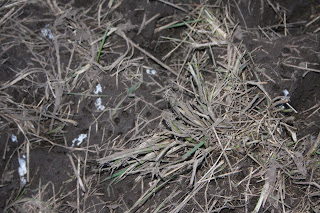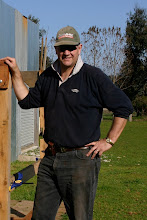The Moora Farm cattle are in paddock 43. It's a paddock we didn't graze last year - because we just had so much feed. In May I got the rank, long pasture mulch mown. The mown grass was then just left on the ground to compost naturally. Even though it was mown in May, there had been good regrowth - more than you would expect in June and July.
 Last weekend I was looking for anywhere to put the cattle that was even slightly drier than the rest. I lit on 43 because it hadn't been grazed and is the highest paddock on the farm. It wasn't dry however. As soon as the cattle went in there they were sinking 2 or 3 inches into the ground everywhere and deeper in the wet spots. Without other options really, I decided to experiment.
Last weekend I was looking for anywhere to put the cattle that was even slightly drier than the rest. I lit on 43 because it hadn't been grazed and is the highest paddock on the farm. It wasn't dry however. As soon as the cattle went in there they were sinking 2 or 3 inches into the ground everywhere and deeper in the wet spots. Without other options really, I decided to experiment.Since then they have been shifted every day. So each strip gets only 24 hours of 'deep tissue massage' from the cattle's feet. The first photo shows 2 strips separated by where the electric fence ran. The second photo shows a close up of the 'damage'. It's not trivial, but I guess the mulched grass from last year is being well and truly incorporated into the top few inches.
 I have been far from convinced that I am doing the right thing, but also reluctant to shift the cattle onto even better paddocks - and have them chop them up.
I have been far from convinced that I am doing the right thing, but also reluctant to shift the cattle onto even better paddocks - and have them chop them up.Then .. this afternoon I noticed something. Over quite a lot of the paddock there are holes about 1/4 inch across. You can see them in the 3rd photo is you look closely. It's not like they are across the whole paddock - but there are a lot.
What could be causing this? I have released dung beetles, but this looks nothing like their work. When I lifted a clump of dirt I was surprised, first, by how friable / non-sticky it seemed. Then ... it was full of smallish earthworms. They look too small to make such big holes - and so many of them.
Does anyone know what the source of the holes is likely to be?
I'm quite hopeful that the seeming mis-treatment of this paddock will have a good end. I think I'll spread, by hand, some seed and then paddock harrow it (once it's dry enough). I'll be very interested to see how it comes back.
The last photo shows the cattle on their new strip tonight. The strip over past this one is very, very wet - still with lots of standing water. I'm going to skirt the temporary fence around this and use it as a bit of a control to compare with the majority of the paddock which will have been all chopped up.
All very interesting.
We had a meeting at our place today and I got to take a neighbour (who is a real farmer - albeit an orchardist) around the pastures. Before John got to see 43, he saw the progress we've made in some of the other paddocks. Hopefully he didn't then judge my 43 experiment too harshly. It is a bit confronting when you see it up close.
I'll report back.
F







No comments:
Post a Comment